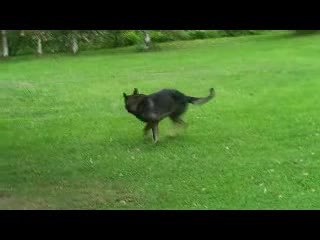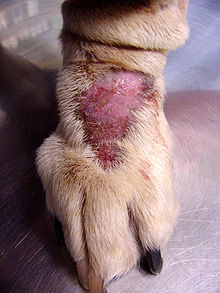
Licking is the action of passing the tongue over a surface, typically either to deposit saliva onto the surface, or to collect liquid, food or minerals onto the tongue for ingestion, or to communicate with other animals. Many animals both groom themselves, eat or drink by licking.

Dog aggression expressed by dogs is considered to be normal behaviour and various types of aggression are influenced by a dog's environment and genetic predisposition. Dogs commonly display possessive aggression when defending resources or themselves.
Skin disorders are among the most common health problems in dogs, and have many causes. The condition of a dog's skin and coat is also an important indicator of its general health. Skin disorders of dogs vary from acute, self-limiting problems to chronic or long-lasting problems requiring life-time treatment. Skin disorders may be primary or secondary in nature, making diagnosis complicated.

The health of dogs is a well studied area in veterinary medicine.
Malignant histiocytosis is a rare hereditary disease found in the Bernese Mountain Dog and humans, characterized by histiocytic infiltration of the lungs and lymph nodes. The liver, spleen, and central nervous system can also be affected. Histiocytes are a component of the immune system that proliferate abnormally in this disease. In addition to its importance in veterinary medicine, the condition is also important in human pathology.
Canid alphaherpesvirus 1 (CaHV-1), formerly Canine herpesvirus (CHV), is a virus of the family Herpesviridae which most importantly causes a fatal hemorrhagic disease in puppies less than two to three weeks old. It is known to exist in the United States, Canada, Australia, Japan, England and Germany. CHV was first recognized in the mid-1960s from a fatal disease in puppies.
Polyneuropathy in dogs and cats is a collection of peripheral nerve disorders that often are breed-related in these animals. Polyneuropathy indicates that multiple nerves are involved, unlike mononeuropathy. Polyneuropathy usually involves motor nerve dysfunction, also known as lower motor neuron disease. Symptoms include decreased or absent reflexes and muscle tone, weakness, or paralysis. It often occurs in the rear legs and is bilateral. Most are chronic problems with a slow onset of symptoms, but some occur suddenly.

Cheyletiella is a genus of mites that live on the skin surface of dogs, cats, and rabbits.

First reported in 1980 by J. Tuttle in a scientific article, feline hyperesthesia syndrome, also known as rolling skin disease, is a complex and poorly understood syndrome that can affect domestic cats of any age , breed, and sex. The syndrome may also be referred to as feline hyperaesthesia syndrome, apparent neuritis, atypical neurodermatitis, psychomotor epilepsy, pruritic dermatitis of Siamese, rolling skin syndrome, and twitchy cat disease. The syndrome usually appears in cats after they've reached maturity, with most cases first arising in cats between one and five years old.
Animal psychopathology is the study of mental or behavioral disorders in non-human animals.

Pyotraumatic dermatitis, also known as a hot spot or acute moist dermatitis, is a common infection of the skin surface of dogs, particularly those with thick or long coats. It occurs following self-inflicted trauma of the skin. Pyotraumatic dermatitis rarely affects cats.
Dogs are susceptible to allergies much like their human companions. Most allergies occur in dogs over 6 months old. A dog that is repeatedly exposed to a particular allergen becomes sensitized to it, and the immune system overreacts to a subsequent exposure, most commonly manifesting in the form of skin irritation. Some of the signs are redness, itching, hair loss, and recurring skin infections from the irritation. Skin irritation may be generalized or localized. The dog may be more prone to scratching and licking at the irritated site, further exacerbating the problem.

Juvenile cellulitis, also known as puppy strangles or juvenile pyoderma, is an uncommon disease of dogs. Symptoms include dermatitis, lethargy, depression and lameness. When puppies are first presented with what appears to be staphylococcal pyoderma, juvenile cellulitis, a relatively rare condition, may not be considered.

Separation anxiety in dogs describes a condition in which a dog exhibits distress and behavior problems when separated from its handler. Separation anxiety typically manifests within minutes of departure of the handler. It is not fully understood why some dogs suffer from separation anxiety and others do not. The diagnosis process often leads to a misdiagnosis as it is difficult to differentiate from other medical and behavioral problems. The behavior may be secondary to an underlying medical condition. With chronic stress, impairments to physiological health can manifest. Increased stress in the dog alters hormone levels, thus decreasing natural immunity to various health problems.

Sebaceous adenitis in an uncommon skin disease found in some breeds of dog, and more rarely in cats, rabbits and horses. characterised by an inflammatory response against the dog's sebaceous glands, which can lead to the destruction of the gland. It was first described in veterinary literature in the 1980s.

Tail chasing is a behaviour exhibited in dogs that is characterized by spinning in tight circles in either direction, and can be slow and focused on the tail or fast and unfocused. It is a compulsion similar to those seen in humans suffering from OCD and it can be quite disruptive to the lives of the dogs themselves, as well as their owners. Some causes have been suggested, including genetic factors, and environmental factors that vary depending on the individual dog. Furthermore, treatment options include drugs that decrease the frequency of tail chasing by targeting the underlying mechanisms, and behavioural changes regulated by the dog's owners.
Autoimmune skin diseases occur when the immune system of an infected animal attacks its own skin. In dogs, autoimmune skin diseases are usually not detected until visible symptoms appear, which differs from detection in humans who are able to verbally express their concerns. Genetics, nutrition, and external environmental factors all collectively contribute to increasing the probability an autoimmune skin disease occurring. The severity of symptoms varies based on the specific disease present and how far it has progressed. Diagnosis often requires the onset of visible symptoms and for a biopsy to be performed. For many diseases, the condition itself cannot be cured, but a veterinarian can prescribe medications and other forms of treatment to help manage the symptoms of the dog.

Fly biting refers to a type of dog behavior: episodes of intentional focused biting at the air, as if the dog is biting at imaginary flies. Cavalier King Charles Spaniels appear to be predisposed to fly catching syndrome, though it has been documented in many different breeds and mixes. Age of onset is varied.











